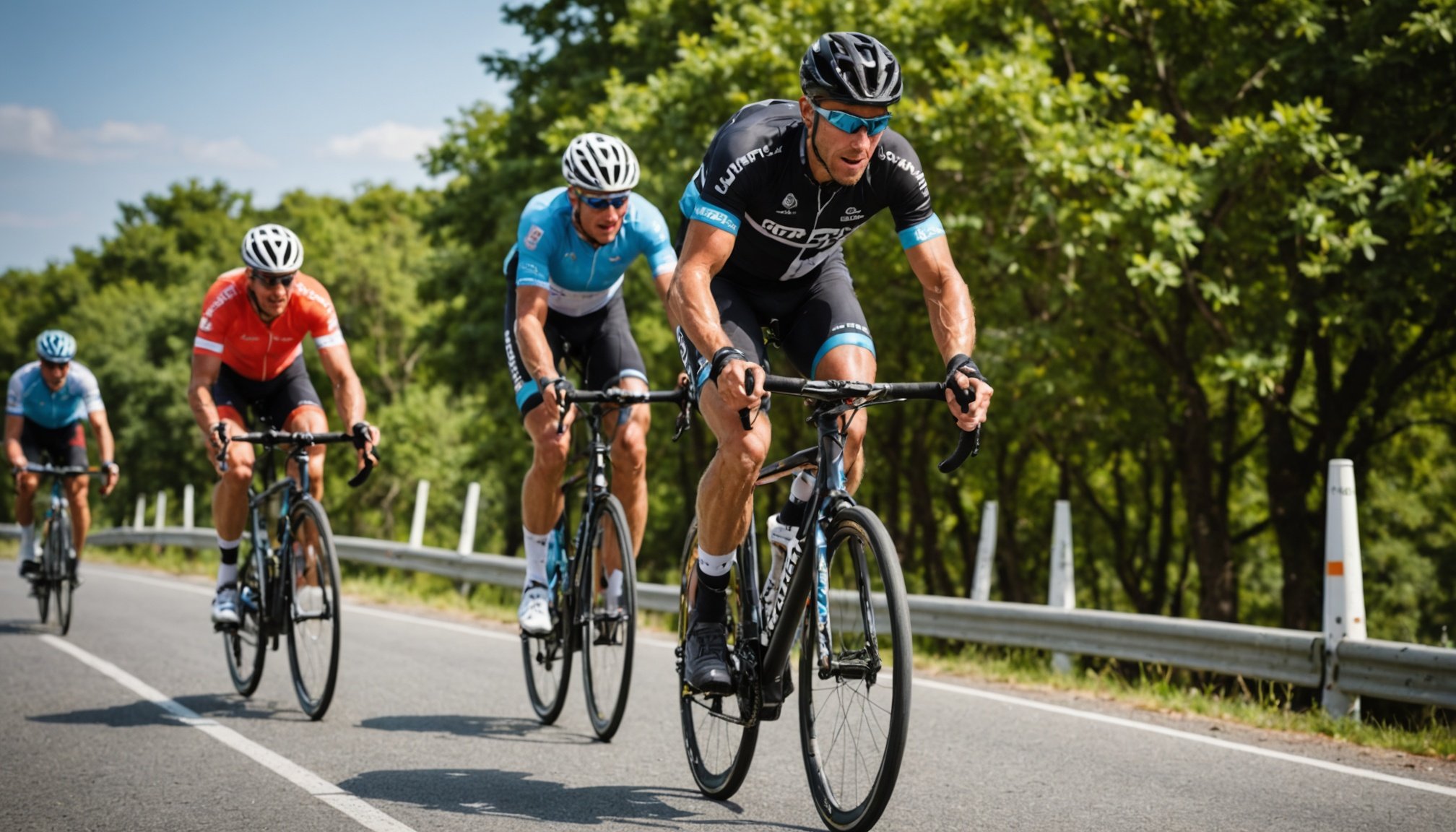Understanding Stamina for Cyclists
Stamina plays a vital role in multi-stage cycling races, often determining outcomes more than raw speed. It enhances endurance, allowing cyclists to maintain optimal performance and recover efficiently between stages. In essence, strong stamina can be the difference between hitting a personal best and falling short.
At its core, stamina involves a cyclist’s ability to sustain prolonged physical activity without succumbing to fatigue. This endurance influences not only cycling performance but also recovery rates, minimizing downtime and allowing for quick returns to peak condition. Key physiological factors, such as cardiovascular efficiency and muscle fibre resilience, are pivotal in building stamina. These factors are developed over time through consistent and targeted training.
Have you seen this : Enhancing shooting accuracy: winning tactics for biathletes to thrive in high-pressure competitions
Endurance training stimulates the body’s energy systems, enhancing the cyclist’s ability to utilize oxygen effectively. While developing stamina may require significant effort, it promises substantial payoffs in overall performance.
Investing in building stamina through appropriate training can yield long-term benefits, including improved race times and a more enjoyable cycling experience. Whether you’re training for a tour or simply aiming to increase daily sustainability, targeting stamina will enhance your resilience and overall cycling prowess.
Also read : Mastering accuracy: must-try mental exercises for biathletes to boost shooting precision
Effective Training Strategies
When striving to enhance cycling performance, crafting an effective training plan is paramount. Different strategies cater to distinct goals, yet they collectively aim to boost stamina and endurance. Among these, interval training stands out as a pivotal component. This method alternates between high-intensity bursts and lower-intensity recovery periods, effectively increasing cardiovascular capacity and muscular strength.
By incorporating intervals, cyclists can challenge their limits, facilitating better oxygen utilization and power output. Long rides also play a crucial role in training plans, helping to build the resilience required for multi-stage events. These sessions enable riders to adapt to sustained exertion over time, fostering enhanced perseverance.
To fully capitalize on training, it’s essential to strike a balance between intervals and endurance rides. A comprehensive plan will not only focus on physical exertion but also allow for adequate recovery, ensuring the body can repair and strengthen.
Tailoring these components to individual needs and cycling goals can result in significant long-term improvements in performance and stamina. Embracing a structured regimen with varied elements is key to unlocking peak potential on the bike.
Nutrition for Endurance
In the realm of multi-stage cycling, sports nutrition is critical for maintaining endurance and performance. A cyclist’s diet should include energy foods, rich in carbohydrates, to fuel their rides effectively. Consuming these foods aids in maintaining glycogen levels, which are paramount for prolonged exertion.
Pre-ride meals should ideally be high in carbohydrates and low in fat to enhance energy availability. During rides, energy gels and bars provide quick glucose replenishment, sustaining cycling performance. Post-ride nutrition focuses on muscle repair and glycogen replenishment, involving a combination of protein and carbohydrates.
Hydration is equally crucial. Monitoring fluid intake before, during, and after rides prevents dehydration, which can significantly impair performance. Electrolyte balance, facilitated by sports drinks, supports muscle function and prevents cramps.
Lastly, don’t underestimate the power of nutrients like antioxidants from fruits and vegetables, which assist in reducing muscle fatigue and inflammation. By following these structured nutrition practices, cyclists can not only improve their stamina but also boost recovery rates and achieve optimal performance. Structured attention to dietary intake is indispensable to conquer the challenges of multi-stage races effectively.
Recovery Techniques
In the realm of multi-stage cycling, recovery strategies are pivotal to enhancing your stamina and ensuring muscle repair. Effective recovery techniques involve incorporating well-planned rest days and methods aimed at reducing post-training fatigue.
It’s crucial to acknowledge that long-term endurance improvements are contingent on allowing your body adequate time to recuperate. Rest days, though often underestimated, are integral in this process. They offer a vital pause for muscles to adapt and strengthen, thus preventing overtraining and burnout.
To further facilitate effective recovery, investing in muscle repair strategies is advisable. Techniques such as active recovery, which involve low-intensity activities, can maintain circulation and prevent stiffness. In contrast, passive recovery focuses on complete rest and relaxation, giving muscles an opportunity to fully heal.
Moreover, practices like stretching, foam rolling, and using ice baths can accelerate muscle recovery, reducing soreness and inflammation. Also, complementing physical recovery with quality sleep and balanced nutrition maximizes repair and reinforces stamina.
Ultimately, a tailored recovery plan ensures cyclists can bounce back stronger, maintaining optimal cycling performance across challenging races. Emphasizing recovery is as crucial as training itself, embedding resilience and readiness for future undertakings.
Real-Life Experiences and Expert Insights
Listening to testimonials from professional cyclists can provide invaluable insights into the significance of building stamina for multi-stage races. For example, experienced racers often highlight how their customized training schedules, rich in interval training, have substantially boosted their endurance and cycling performance.
Cyclist experiences also shed light on the emotional and physical challenges they face. Many testify that balancing training intensity with adequate recovery strategies ensures higher energy levels and resilience. The stories of athletes overcoming barriers exemplify the strength and determination needed to excel.
Expert interviews provide further depth, offering actionable advice on conquering stamina challenges. Coaches often emphasize a multifaceted approach, combining focused training plans, sports nutrition, and recovery techniques to sustain high performance. Experts underline the importance of individualized plans, as each cyclist’s body and goals differ.
These real-life perspectives, combined with expert guidance, are powerful tools for cyclists aspiring to elevate their cycling performance. By learning from others’ successes and obstacles, cyclists can develop holistic strategies that align with their unique journey, unlocking peak potential and enrichment on the cycling path.
Visualizing Your Progress
Visualizing progress effectively can transform your cycling performance. Training charts and graphs offer indispensable insights, enabling cyclists to track stamina improvements with precision. Measurable metrics in these visual tools shield against subjective biases, ensuring honest self-assessment.
Progress tracking is crucial for setting and pursuing endurance goals. By clearly defining targets, cyclists can better structure their training, yielding more consistent and targeted development. Adopting a strategic approach facilitates increased motivation, driven by the visualization of tangible improvements over time.
Numerous tools and apps are at cyclists’ disposal, designed to aid in tracking performance and progress. These technological solutions offer real-time data on ride metrics, such as distances covered, elevation gains, and heart rates, among others. This data aids not only in assessing current stamina levels but also provides benchmarks for future development.
Beyond just numbers, these tools foster personalised feedback, encouraging cyclists to adhere to and adjust their training plans as needed. Embracing these resources, along with their graphical representations, empowers cyclists to not only measure their stamina but actively work towards enhancing it, pushing boundaries in their cycling journey.











